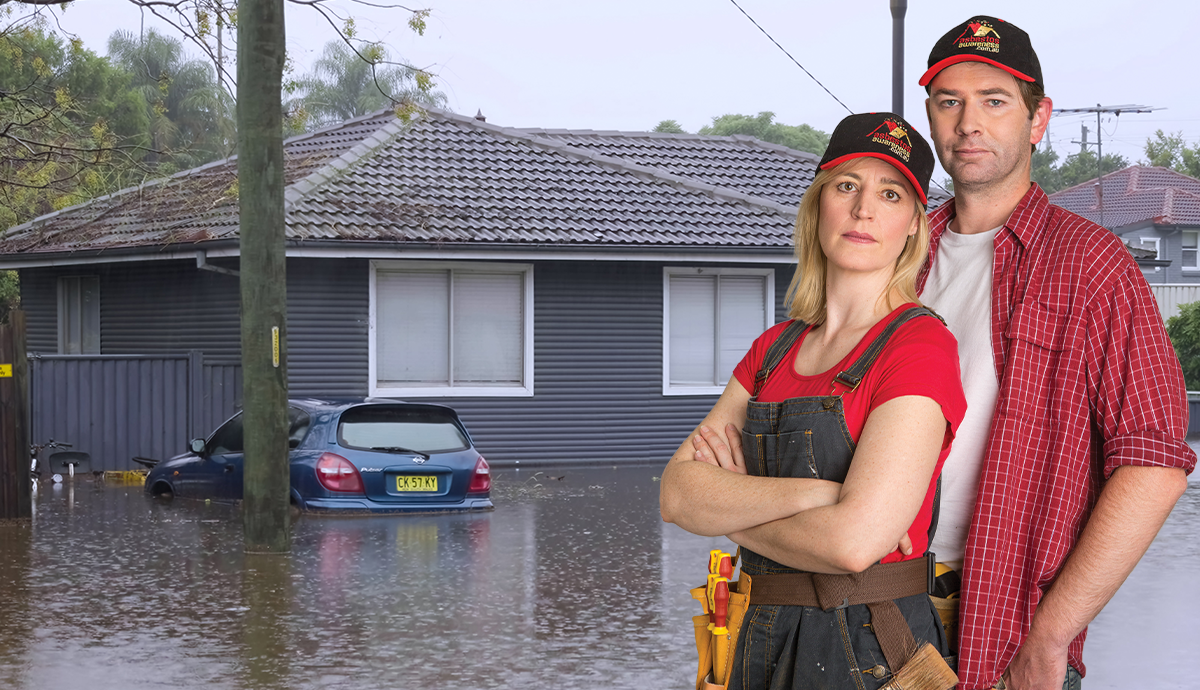

MEDIA RELEASE: 10 March 2022
Flood Victims Warned of Asbestos Risks Caused by Torrential Rains, Winds & Floods
Visit asbestosawareness.com.au – it’s not worth the risk!
Whilst relentless rains, storms and floods hammer vast regions of NSW and Queensland, homeowners, businesses, commercial and rural property owners are being warned to prepare for the hidden danger of asbestos that lurks in one in three Australian homes and in rural and commercial property structures.
Countless numbers of homes, businesses and rural properties have been destroyed or damaged leaving thousands homeless, waiting for floodwaters to subside before commencing the heartbreaking task of cleaning up, and in many cases rebuilding after homes and businesses have been completely destroyed.
Cherie Barber, Ambassador for the National Asbestos Awareness campaign is urging impacted property owners, residents and volunteers to be wary of potential dangers posed by damaged asbestos-containing materials found in homes, buildings, structures and flood debris that may have washed onto their properties.
“When homes and other buildings containing asbestos are damaged or destroyed during floods, wind and storms, asbestos-containing materials can become eroded, disturbed, broken or friable causing a health risk to homeowners, property owners, property managers and the community if these materials aren’t managed correctly and disposed of safely,” Ms Barber said.
“Before commencing the clean-up, to protect themselves, their families and communities; property owners must visit www.asbestosawareness.com.au to learn how to identify and manage asbestos safely.
“They should also contact their local Council or Emergency Services for important information about asbestos and if asbestos needs to be removed, please only use professional licenced asbestos removalists because it’s not worth the risk,” she said.
Asbestos was used in the manufacture of more than 3000 building and decorator products that can still be found in any brick, weatherboard, clad or fibro home built or renovated prior to 1990. It was used everywhere and may be in many forms including flat or corrugated sheets (fibro) used for walls, ceilings, roofing or in products such as pipes, electrical conduit, eaves, wall and floor tiles and other structures including garages and garden sheds.
In many coastal regions hit hard by the current flood disaster, often original ‘weekenders or shacks’ were constructed from flat and corrugated (fibro) sheeting including external and internal walls and ceilings, while in rural and regional areas, homes; fences, storage sheds, chook sheds, out houses and stock sheds may have been constructed from asbestos-containing materials.
Asbestos was also commonly used in the construction of commercial and non-residential properties such as shops or public buildings prior to December 2003.
Bret Baker, President of the Asbestos & Hazmat Removal Contractors Association of NSW (AHRCA) and a Civil and Environmental Engineer with more than 25 years experienced in asbestos removal and demolition warned property owners of the serious hazards after floodwaters subside including asbestos.
“It’s important that property owners and volunteers do not walk on corrugated asbestos roofs or enter any buildings until authorised to do so by Council or Emergency Services,” Mr Baker said.
“Erosion, heavy rains, winds and tree branches may have caused additional damage to already aged asbestos roofs as well as the walls of the structure. While homes, commercial properties and other structures (sheds, garages and stock sheds etc.) may be structurally unsound and vulnerable to collapse.
“Other potential hazards property owners need to avoid include damaged asbestos-containing materials, sharp edges, protruding nails and broken materials including glass and timber that could be found in building rubble, damaged structures and flood debris,” said Mr Baker.
“When it comes to managing asbestos, the first rule is, if you think a building material, product or debris may contain asbestos, treat it as if it is asbestos and take all the necessary precautions in line with regulations,” he said.
“When storms and floods hit, whole buildings and even stockpiled asbestos-containing materials (particularly flat or corrugated sheeting commonly known as fibro) can be picked up by floodwaters and moved from one location to another.
“So, even if your home was built after 1990, it is likely that during floods, miscellaneous debris and rubbish including asbestos-containing materials from elsewhere can end up on your property and pose a risk.
“Should you find displaced structures and debris containing asbestos on your property, it’s vital that these materials are managed safely and in line with regulations,” Mr Baker said.
Homeowners, commercial and rural property owners and managers should visit www.asbestosawareness.com.au for information on how to identify asbestos-containing building materials and decorator products and find out what they need to know to manage asbestos safely following storms and floods.
-ENDS-
MORE INFORMATION ON SAFE ASBESTOS MANAGEMENT FOLLOWING FLOODS & STORMS
asbestosawareness.com.au is Australia’s leading, most comprehensive, trusted asbestos information source. Since launching in 2011, the website has had over 2.2 million pageviews, more than 1 million sessions while its unique resources (fact sheets, guides etc.) have been downloaded over 500,000 times.
IMAGES: https://asbestosawareness.box.com/v/flood-damage
INTERVIEW REQUESTS:
INSIGHT COMMUNICATIONS 02 9518 4744 | info@asbestosawareness.com.au
HASHTAGS
#AsbestosAwareness #Floods #NSWFloods #QLDFloods #RespectAsbestos #RespectAsbestosRisks #AsbestosRisksInFloods #AsbestosSafety #AsbestosAndFloods #StormDamagedAsbestos #FloodDamagedAsbestos #AsbestosAndStorms #Floods2022 #AustralianFloods
SPOKESPERSONS
Cherie Barber – Asbestos Awareness Ambassador
Cherie Barber is widely known as Australia’s Renovation Queen™. Cherie is a regular TV renovator, highly sought-after public speaker, author and award-winning businesswoman with her Renovating For Profit career spanning more than 30 years. Cherie lost her grandfather to asbestos-related disease and has been a dedicated Ambassador for the National Asbestos Awareness campaign to educate homeowners and DIYers on how to renovate homes with asbestos safely since 2013.
Bret Baker – Asbestos Awareness Spokesperson
Bret Baker is President of the Asbestos & Hazmat Removal Contractors Association of NSW (AHRCA), is a Civil and Environmental Engineer and the Managing Director of Beasy Pty Ltd with more than 25 years’ experience in asbestos removal and demolition. Bret is a long-time industry representative on a number of government asbestos and demolition advisory committees and has presented at state and national asbestos forums on asbestos-related industry issues.





